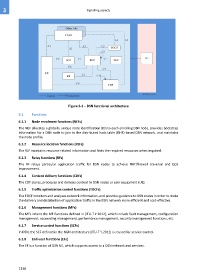Page 1348 - 5G Basics - Core Network Aspects
P. 1348
3 Signalling aspects
Figure 6-1 – DSN functional architecture
6.1 Functions
6.1.1 Node enrolment functions (NEFs)
The NEF allocates a globally unique node identification (ID) to each enrolling DSN node, provides bootstrap
information for a DSN node to join to the distributed hash table (DHT)-based DSN network, and maintains
the node profile.
6.1.2 Resource location functions (RLFs)
The RLF maintains resource-related information and finds the required resources when inquired.
6.1.3 Relay functions (RFs)
The RF relays particular application traffic for DSN nodes to achieve NAT/firewall traversal and QoS
improvement.
6.1.4 Content delivery functions (CDFs)
The CDF stores, processes and delivers content to DSN nodes or user equipment (UE).
6.1.5 Traffic optimization control functions (TOCFs)
The TOCF monitors and analyses network information, and provides guidance to DSN nodes in order to make
the delivery and distribution of application traffic in the DSN network more efficient and cost-effective.
6.1.6 Management functions (MFs)
The MFs inherit the MF functions defined in [ITU-T Y.2012], which include fault management, configuration
management, accounting management, performance management, security management functions, etc.
6.1.7 Service control functions (SCFs)
In DSN, the SCF defined in the NGN architecture [ITU-T Y.2012] is reused for service control.
6.1.8 End-user functions (EFs)
The EF is a function of DSN UE, which supports access to a DSN network and services.
1338

